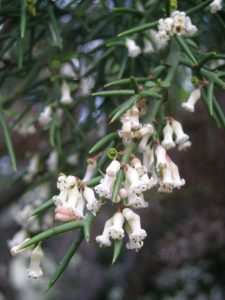From Ecuador to Argentina, Colletia spinosissima will defeat any grazing predator with the angled vicious green spines. These plants are often found as single specimens in grazed land, due to this growth habit, companion vegetation is often rich and diverse. The spines and young stems are green, photosynthesising in the absence of leaves. On maturing they striate brown.
A member of the family Rhamnaceae, the flowers, held beneath the spine axis, are pink in bud, opening white and delicately scented, if the flower is picked and pulled apart this scent deepens, reminiscent of a washroom hand soap. The corolla is tubular, folded back at the end, star like. The protruding anthers are covered in yellow pollen which once dispersed reveals the black surface. The filaments are fused to the side of the corolla tube, running up the centre of which is the translucent style. Seed pods are mahogany brown in three parts with a seed in each. In a moment of warmth these open and the seeds, (shiny dark purple), are projected a distance. In Chile they are parasitised by a Chalcid wasp so fertile seed is not often produced.
The specimen growing to the east of the Orchid house is in need of dead wooding, who will volunteer for this task?
Tucked to the back of a bed north of the Linnaeus memorial is C. paradoxa, the leaves modified to cladodes, flat, angled and also vicious with terminal spines.
The second image shows C. hystrix with pink flowers, collected in Chile and thriving at (costa del) Musselburgh in the garden of Pete Brownless. This area to the east of the city often registers overnight temperatures several degrees warmer than those experienced here in the garden making this type of planting more successful.

